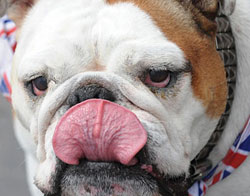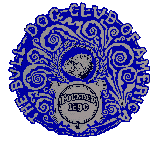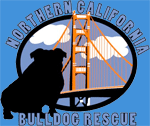Bulldog Health Study at UC Davis
Matt Mellema, DVM
Presented live to BCNC, June 8, 2012
following BCNC Supported Entry Show, Vallejo.
Recording and transcription by: Suzie Rose, RVT, BS
» Health Study Contact Information
Dr. Mellema is originally from Los Altos, California. When he was young, he worked at the Oakland Zoo for Dr. Joel Parrott, Executive Director of the Oakland Zoological Society. While working with Dr. Parrot, Matt decided he wanted to become a Veterinarian. He graduated from the UC Davis School of Veterinary Medicine in 1994, followed by an Internship at Tufts University in Boston, Massachusetts. He then returned to UC Davis for his Residency program, before going back to Boston to complete a PhD in Respiratory Physiology at Harvard University.
His research training is all about how the respiratory system works. The lab he worked in was mostly an asthma lab, and even though that [asthma] was not what he wanted to work on, it had the right people he wanted to work with. In 2007, Matt's old boss at UC Davis retired, and he took over the position. He's happy to be back in Northern California, since this is where his family is.
The following is quoted (verbatim) from Dr. Mellema's presentation:
"My job at UC Davis is to run the emergency room for small animals in the Intensive Care Unit. If your dog (or cat, no rabbits – deathly allergic!) has an acute injury or illness, it would be my job to make sure they get the care they need; our most critically ill patients are going to come into my ward and I'm going to take care of them. I'm probably not your go-to-guy for itchy skin, that's not what I do, BUT, I will help you with anything with your dogs because even though I'm not a dermatologist I know lots of them! We have all of the resources you could possibly imagine, so that's really what brought me here.
I'm 44 and I have about 20 good years left before I'm gonna 'hang up the spurs.' I've reached a point in my career where I said, "I don't have to prove anything anymore, I'm satisfied with my job, now I want to look for something big to work on." Bulldogs are my big thing to work on. The reason why is because I take care of so many of them – at least 30% of my patients in ICU are brachycephalic dogs. There's lots of Bulldogs in Northern California, as you all know, this is Bulldog territory! They're immensely popular in my practice, which spans really all of Northern California and beyond. The farthest Bulldog that came to see us came from Moscow, Russia, so we've seen Bulldogs from all over the place.
Part of it is because the nature of my practice, and part of it is because – and I don't have to convince you guys of this – they're amazing dogs, incredibly stoic, they form these amazingly strong bonds with their people and I'm fortunate that they're the bulk of my practice because we just love them and it's hard not to.
But, we're also quite worried about them. There's a reason we see so many of them in ICU, and I think we've been wrong about the reason we're seeing so many of them. I think I don't have to convince anyone [here] that what we all love about their head conformation comes with a cost – they get obstructions in their upper airways, the oxygen in their blood drops very low when they sleep, and the research so far, from the University of Pennsylvania, would say that Bulldogs are the worst out of all the brachycephalics, that they're suffering the most when they sleep – based on their [oxygen] saturation – that they're having obstructive sleep apnea. With people, we have the option of putting a CPAP mask on them – we can't do that with Bulldogs. It would be great if we could, it would work wonders for them.
All of us up [at Davis] with the team I'm assembling are very concerned that we're looking at the brachycephalic syndrome the wrong way, that we're treating it like it's a local disease, like it's just a condition affecting their upper airways, and in the last couple years one of my residents and I have published a series of papers showing more and more evidence that it's not just a respiratory disease, that there are effects of that on the whole body. What we see with obstructive sleep apnea in people, and that's so concerning, is the number of pretty serious systemic diseases, slow to build up, they aren't eye catching – they take a small toll over a long time – things like hypertension, blood pressure is too high.
We just published a paper with a group of Bulldogs – mostly Bulldogs, there were other brachycephalics (short, broad skull) as well, and some dolicocephalic (long, narrow skull) dogs – and the brachycephalics had higher blood pressures, higher than the other group, higher than they should. The other thing is their red blood cell count is higher than the other dogs, which is another thing they see with people with sleep apnea (since red blood cells carry oxygen in the blood, the body tries to compensate by producing more of them to circulate more oxygen). I think as we get more and more of this data out of our study, we're concerned that if we continue to focus on what's going on up here [around the upper airway], we're missing what's going on everywhere else.
We really want to find ways to start improving the overall health of Bulldogs, not just 'do they or don't they' need surgery – open up their nostrils, do they need a little bit of their palate removed – look at it more holistically, what can we do to improve their health overall.
I think another problem that we've picked up on is that the surgeries that we do for Bulldogs and other brachycephalic breeds don't get all the problems. Yes, the nostrils can be a little narrow in some affected dogs and we can open those up; yeah, the palate can be too long and we can trim that off; there are some saccules in their throat that can get too big and everted (stick out and obstruct the airway), we can trim those off.
But, there's still a problem there, which is their tongue. Not all of their tongues, but some of their tongues. If you spend enough time with Bulldogs, in their throats, as I do, you see that they're not just long – which is a problem, because they do pull them back in and there's only so much space in that mouth – they're also quite thick. The base of their tongue is very thick, and it doesn't help if you trim off the back of their palate, and the tongue is still so thick that it's still obstructing them, and we still have a problem.
So, one of the things we're working on is something with the company, Olympus, the ones who make the cameras. They make equipment for this really quite amazing and minimally invasive treatment that they do in people with large tongues (macroglossia), that can help shrink the tongue – just the base – permanently. So, we've been working with this and trying to bring this as a treatment option for brachycephalics. I think the beauty of that treatment is that it's just a little "buzzing sting." It's just an outpatient procedure - come in, it takes 5 minutes, you go home. It shrinks over a matter of weeks.
They also have another probe that you can put into the palate, so instead of cutting it off, you can shock it and it's going to retract over a period of a couple of weeks. It means they can be anesthetized with something reversible. We can give it [anesthesia] to them, do the procedure, reverse them, and just like that – they're up! That's what we're looking for. Also, part of what we ignore is all of the nasal turbinates (small bones inside the nose that trap dust and humidify the gasses we breathe in, etc.) that brachycephalics have more of farther back and are excessive and can make it harder to breathe through the nose; so even if we open up this [nostrils], we still have more problems back here [nasal cavity].
Olympus also makes a probe for people that reaches back there and can help shrink up that tissue and make is so they can breathe through their nose. So, long term, where we would like to go with this procedure, somnoplasty (somno = sleep, plasty = revising/forming the tissue), with Olympus and UC Davis, is we want to make this something we can offer.
We're not there yet. Because, what we need are some other tools. Right now, if I ask you if your dog has brachycephalic syndrome what are you going to base it on? How do you decide? The dogs have obstruction while they sleep, coughing up phlegm, heavy snoring, stridor, high pitched gasping. We all agree it's subjective. Who breathes like that? Almost all Bulldogs breathe like that (just an example of what people say). It can be very hard, not just for you, but for us to say, "how much is this affecting them? Is it just noise, or is it having a medical effect?" There are no objective measures for that.
What we're embarking on right now is to develop the tools, rather taking the tools that are used on people, particularly the ones used on infants because they can't cooperate, can't do all the procedures that an adult can do. They have some techniques they use to identify how bad their oxygen levels are going down at night, that are really minimally invasive, like blood sample, pee in a cup, that level of invasiveness.
So, what my staff and I are working on is bringing those tools to bear on Bulldog health issues. If you catch the first bit of urine from your dog in the morning, throw it in a vial, freeze it and send it to me, I can tell you how bad things are at night for your dog; I can tell you whether there are going to be long term consequences or whether the surgery is even going to help. Then, it would also give us a set of tools to decide whether somnoplasty is better than the stuff we're doing now.
Another question, is the stuff we're doing now even doing anything? We're basing that on even subjective measures. We do the surgery and you say, well they seem to snore a little less. Ok. Did that make him healthier? So, we want to start answering those questions. But, to do that, we need partners.
We need at least 12 dogs. We want help to establish whether these will help with your dogs. We have ways; we have pulse oximeters and other techniques to see if they're desaturated, but that means a full sleep study in the hospital up at Davis. What we want to do is have at least 12 dogs and do a full sleep study, but at the same time be collecting these other things like urine and blood tests to see if we can use those instead. That way you can get those done by your veterinarian locally, or by catching the urine in your home and sending it to us, rather than bringing your dog in for a sleep study. Sleep studies are a pain. You have to drive your dog to Davis, you gotta leave the dog with me a couple days, you gotta come back and get him. This economy is not the time to be taking two different days off work, nobody wants to be doing that. But, we need a dozen Bulldogs who want to help us get this established.
[Question from audience member about checking blood gases.] We can check blood gases all day long, but the problem is that blood gases while they're awake tells us nothing about blood gases while their asleep. In the 90's, with the work that Joan Hendrick did at Penn (Penn. State Univ.), she found the same thing. She tested blood gases and had beautiful, pristine results while they were awake. Then, she would do the sleep study and they were horribly desaturated at night.
So, we want to start developing these tools, for you guys, to start saying which of your 'kids' need medical attention, and which ones don't. Once we can grade severity, it should not only be able to tell us whether they're desaturing when they sleep, but will tell us how bad it is, how low is it going, how long is it staying there? That gives us a set of tools to then say, "are the treatments we're doing working? Is this new treatment better?"
One of the reasons we want to do that is we need to see that if we can get this minimally invasive approach working, if we do it when they're young – between year one and year two – can we get it so the Bulldogs never have that problem, so their blood count never goes up, so that they never develop insulin resistance, or Type II Diabetes? The sleep apnea comes with a lot of really horrendous consequences – it's all about oxidative injury. "Oxidative Injury" is bread going stale, that's oxidation. It's all of us going stale, that's aging!
So, do you think Bulldogs age too quickly? [Audience answers 'yes.'] Would you say the median age of the typical Bulldog is about 10-12 years? [Audience answers 'yes.'] I think that's exactly what it is. So, there was a study that was done at Texas A and M, by Kimberly Greer, she looked at 771 dogs, all AKC registered, confirmed they were the breeds they were claiming to be, and looked at age. The Bulldogs are in that 10-12 survival, life expectancy of 10-12 years. But, all the other dogs with that size body live longer.
So, I said, "I'm in that point in my career where I'm looking for some big contribution to make, something to dedicate myself to." I think Bulldogs living two years shorter than they should, is a pretty good thing to try to tackle. I have 20 good years left, I want to add two years to life, at least for our 'kids.' I would love to have Northern California Bulldogs be the example, 'these are what healthy Bulldogs are like, these are Bulldogs that live a long time and have a quality life.'
[Question from audience member: Can they be bred back to have the good 'things' in them that they used to have before they were bred to be the way they are now, since they used to be healthier?] It's a really interesting question as to whether or not we can change the breeding. My answer to that is yes and no. You guys might have heard of Danika Bannasch (DVM, PhD) at UC Davis. She's the one that discovered the mutation that causes the high uric acid levels in Bulldog urine, the cysteine stones (HUU – Hyperuricosuria). She has an office right down the hall from me, and we were talking about Bulldog genetics. I think one of the things that I'm interested in doing is (one of the other tools we can use is non-invasive ultrasound, coming up under the jaw – at the throat – and looking at their tongue) taking a puppy, for example at 15 weeks, and say, "how big is that [tongue] going to be when she's full grown, how much of a problem is it going to be?" So, then we can actually decide – if we were going to approach the breeding – we don't want to change this [gesturing the whole front of the face], that's what makes them Bulldogs – I want to change the tongue, I want to breed them to get the tongues out of the way. That doesn't change any of the things we love about them on the outside.
The AKC doesn't have any points assigned to their tongue; there's no Breed standard for their tongue. So, we could shrink it up. So, we talked about whether we could identify genetic markers for who's going to have a big tongue, and who's going to have a more modest tongue that's not going to get in the way, and maybe we could approach the breeding that way. Let's keep Bulldogs, Bulldogs, and maybe we can find a way to breed that tongue out of the way.
[Comment from an audience member: I have a dog with a big tongue that breathes great.] I think you can't tell them apart. The problem is that they can look great here [gesturing to front of face], it's the base back here, in the back of the throat [gesturing behind jaw]. I think, unless you've had a CT scan of your dogs tongue you don't know how big it is, you've only seen the outer portion. The part back there that you put the tongue depressor on [gesturing toward back of jaw again], that's the part. I've looked at every CT scan Davis has done on Bulldogs in the last ten years, which is when we started digitally capturing them, and it's incredibly variable. I can see dogs whose tongues spread out like a gigantic pancake here, [gesturing in front of mouth] but, are really modestly enlarged here [gesturing behind jaw], and other dogs with small tongues and big back here [gesturing behind jaw again].
[Question from audience member: Do you find any correlation in the thickness of the tongue or with the ones that hang out more?] We haven't started that. I wanted to answer that question. The problem is, I assigned a student last summer to actually go through all the CT scans and make a 3-D reconstruction of every tongue. But, when they do the CAT scans, they don't capture the whole tongue, there's always so much hanging off the end, and I have no idea how much it is! We weren't doing the scan to see how big their tongue was! So, I tried to answer that question. But, what I think we should be able to do is with just a quick ultrasound up here [gesturing at throat, below jaw], is be able to look.
But, this is another one of those things where we're going to need a dozen dogs to see if this is of any use. We'll probably need more puppies, around 4 months, let's see them and then follow them. Take a look at the tongue, go home, we'll see you in a year, come back. We will predict who is going to have a big tongue, and who isn't. Then we do these tests, and if we find the ones who have the big tongues are having the most trouble breathing, ok, then we have something we can target. We can target it minimally invasively with the somnoplasty to help 'that' dog.
We can change the breeding. If we can find what they call a quantitative trait loci, part of the chromosome that's associated with a big tongue, we can use that as a breeding target. So, did I mention we're going to look at this over the next 20 years! [lots of laughs] It's not going to happen overnight. For the study, I'm looking for some dogs that are older, that have sired or whelped a couple of litters, so we have some progeny to follow. If they've had palate and/or nares trimmed, etc., they can still contribute.
The beauty of this project as we're going forward, with everything we're planning on doing over the next couple of years, is that participation can go from very minimal, to the whole nine yards. If you want to be one of the magic 12, to help establish the study, great! We'll set you up to come up to Davis and we'll treat you like royalty. If you want to do something more modest, if you want to come up for a day, if you just want to submit a cheek swab, want to give some urine and an objective assessment of how your dog breathes, absolutely, there's ways to participate that take no time at all, and you don't have to come to Davis. Or, there's ways, for those of you that it doesn't seem like Yolo County is China, you can go the whole nine yards. It's scalable. You can make whatever contribution you want.
So, I have a question for you guys, since I told Suzy [Holleran] I would talk about something in particular, which is pneumonia, how many of you guys have had one of your Bulldogs battle pneumonia? [Quite a few hands go up in the audience.] Do you guys have the impression that Bulldogs are more prone to pneumonia than some of the other breeds? [Lots of 'yes' responses, and comments about aspiration (pneumonia).] I feel the exact same way, in that I just spent last Christmas with a Bulldog, named Bogart, from Napa. Bogart came to the teaching hospital to have his ear canal removed, it had been infected for so long, and he was in so much pain, that we had to do the ear canal ablation, and he aspirated, after the surgery. He went into a very severe pneumonia.
The worst thing that can happen with pneumonia is that it progresses into this massive form of pulmonary edema called ARDS (Acute Respiratory Distress Syndrome). Bogart got ARDS. He spent Christmas on the ventilator (mechanical respirator), he spent Boxing Day on the ventilator, he spent New Year's on the ventilator. And what should be a pretty straightforward surgery (ear canal ablation) for a skin problem, turns into $30,000 worth of mechanical ventilation. And, he survived that. Only about one third of dogs that go into the ventilator come off alive. And, then, he had cardiopulmonary arrest, had CPR. He survived that, and he's actually running around Napa right now as we speak.
What I didn't mention is that Bogart is 12 years old! He's about the toughest Bulldog that I've ever met. He defied all expectations I had that day. But, that's where pneumonia can go. There's pneumonia where we go 'here's five days worth of antibiotics, feel better,' then there's pneumonia-pneumonia!
[A serious concern was then brought up by multiple audience members, referring to the recent New York Times article (Nov. 2011) that grossly misrepresented Bulldogs and Bulldog breeders, and created a very negative feeling toward them and our Breed. 'How much of this is going to be used against us later on for these tests? It was a veterinarian that did the study.' 'We don't want anything negative about the Breed.' 'We need to know honestly how much you are going to use this so we have to change our breeding, like they are in England, it's not right.' 'We want to help, but we don't want it to be held against us.' 'It was so biased.' 'Have you come across this?'] I've heard this, but I will go back and read it again. I guess I would see it as the opposite, because what we're trying to do, long term, is help the dogs and find a way to – with the tongue – address, through breeding, the respiratory health.
The way to combat people is to prove the health of our dogs and extend their life expectancy, be a model for the rest of the world about how to care for these guys. Right now, what I wanted to do is come meet you all, and let you know that up there in Yolo County there are people who want to help. Help the Breed, help the individual dogs, help the Association, help the Club, and that we've got lots of ideas, we've got grant money to make these things happen. We're looking for partners, people who want to join the team.
My long term vision – I've got 20 years to get this done – is to find the problem, as far as how much respiratory disease is actually out there within the Breed, and can we use these tools without having to do much to the dog to figure out how severe it is? We can develop some things like focusing on the tongue to make it easier for them to breathe, to find out who's going to have trouble as adults while they're still puppies. There's lots of things we can do for the oxidative injury. We can come up with nutritional supplements, specific antioxidants, they're going to help some of the effects.
Long term, after we get these first few projects off the ground, the plan would be to really try to establish a Bulldog Health Center. We're not talking about a brick and mortar center, we're talking about academics. This center, that center, sometimes it's an actual, physical structure, but, more often, it's just a nucleus of people who want to get something done.
That means me, my resident who's doing a PhD over the next five years in this area, he's going to be in my lab devoting all of his time to this. We have Stan Marks, our gastroenterologist, and Phil Mayhew, our minimally invasive surgeon. They're figuring out new ways to address hiatal hernias that some of the Bulldogs get. So, we want to help them find Bulldogs who have hernias to try and come up with a minimally invasive way to fix it so it stays fixed. We have right now probably the premier brachycephalic surgeon on the planet. We just stole her from Sydney, Australia. If I had any brachycephalic breed that needed surgery on their airways, she's the one who should be doing it.
I didn't make this happen, I can't claim credit for it, but all these amazing people who are useful to me have all sort of, through all these different mechanisms, assembled at UC Davis! We have a team that if I could have gotten to hand-pick it, would have been the people I would have picked. There may be two or three people missing and I'm still trying to get them!
I'm talking about over the next decade, we can take baby steps and get there. We can get a diet for Bulldogs that's hypoallergenic, does good things for their skin, helps keep their weight in the target where we want it to be, that's rich in antioxidants that help keep them from going 'stale,' like we all do. But, I think there's a lot we can do.
How to Participate
We are looking for dogs who want to participate, depends on how far you are, if you want to travel, or send me stuff in the mail. It's so flexible, if you want to participate, your level of participation may be just telling your friends. I'll come to your club events and talk about what ever topic you want. You can have the most overeducated Bulldog club on the planet! Please feel free to email me with your questions about the study and the many ways you can participate. Thank you all so much!"
Health Study Contact Information
» Back to top of this page.
» Back to Bulldog Information.
|

Download Forms
»BCNC Membership Application (pdf)
|









